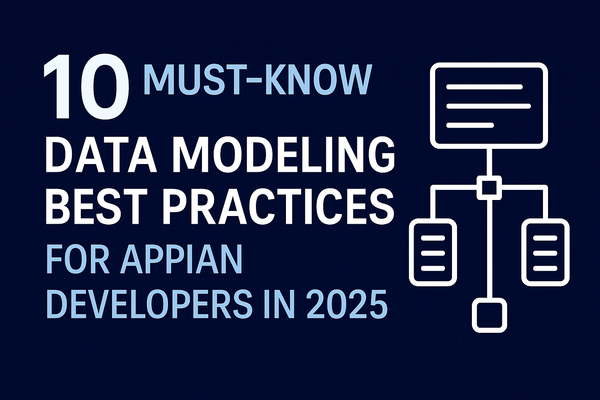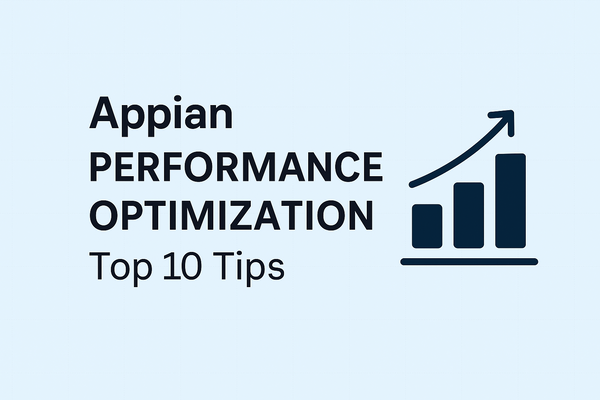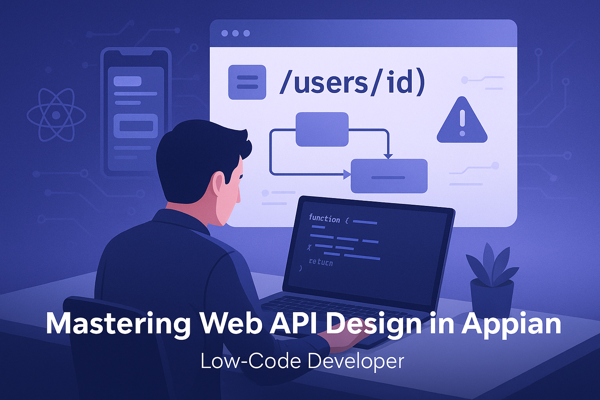
10 Must-Know Data Modeling Best Practices for Appian Developers
When you're building powerful enterprise applications in Appian, your data model is the foundation. Poor data design leads to sluggish interfaces, bloated queries, and endless debugging cycles. In this blog, I’ll walk you through 10 tried-and-tested best practices for data modeling in Appian, with real-world examples and tips from my experience as an Appian developer.
1. Use Proper Normalization – But Not Over-Normalization
What it means: Normalize data to avoid duplication, but don’t split data into too many tables if it’s not needed.
Bad Example:
Customer
- id
- name
CustomerAddress
- id
- customer_id
- line1
- cityToo normalized for a simple app. Retrieving a customer profile now needs joins.
Better Example:
Merge addresses into Customer CDT if the address isn’t used elsewhere or rarely changes.
When to normalize deeply: When dealing with reusable data (e.g., Country, Currency).
2. Always Use Surrogate Primary Keys (Auto-Increment IDs)
Use id fields with auto-increment values instead of natural keys like email or username.
Why:
- Easier updates
- Natural keys can change
- Better indexing and joins
Appian Tip: Always define id as primary key in CDT and database schema.
3. Index Foreign Keys and Filtered Columns
Why: Indexes speed up queries in record list views, reports, and syncs.
Example:
Subscription
- id (PK)
- user_id (FK, INDEXED)
- plan_id (FK, INDEXED)Tip: Index columns used in filters and sorting. Use EXPLAIN in SQL Server/PostgreSQL to check query performance.
4. Use CDT Versioning and Naming Standards
Why:
- Avoids issues during schema changes
- Helps rollback and migrate cleanly
Example:
Instead of Customer, use:
Customer_v1Customer_v2
Pro Tip: Maintain a changelog of CDT changes in your documentation.
5. Avoid Storing Redundant Data (unless denormalized for performance)
Redundant data causes sync issues and increased maintenance.
- Bad: Store user full name in every related table.
- Good: Fetch from the
Userrecord when needed.
When to allow duplication:
- For reporting performance.
- When data rarely changes (e.g., a snapshot of the user profile at the time of a transaction).
6. Optimize CDT Structure for Sync and Scalability
Why it matters: Poorly structured CDTs can cause syncing issues, unnecessary data loads, and performance bottlenecks.
Best Practices:
- Avoid deeply nested CDT hierarchies unless needed
- Keep frequently accessed fields in the top-level CDT
- Use primitive types (Text, Number) instead of custom types where relational mapping is not required
Example:
Instead of embedding the full Plan CDT inside a Subscription CDT, just reference planId, and build a relationship in the record type.
Bad:
Subscription{
id
plan (Plan CDT)
}Better:
Subscription {
id
planId (Number)
}Then use related record configuration to fetch Plan details in the interface or report.
Tip: Reduces payload size and simplifies record syncing.
7. Model Relationships Clearly (1-1, 1-M, M-M)
One-to-Many:
- A
Plancan have multipleFeatures - Store
plan_idinFeatureCDT
Many-to-Many:
Use join table: User_Plan_Map
user_id | plan_id
--------|--------
1 | 2
1 | 3Tip: Use related record types to model relationships properly in Appian.
8. Think in Terms of Record Types Early
Appian’s Modern UX relies heavily on Records. If your data model doesn’t support syncing, record actions, and relationships easily, it becomes hard to scale.
Design Tip:
- Make each core entity (User, Subscription, Plan) a record type
- Use relationship fields from start
9. Avoid Too Many Joins in Reports
If your report/dashboard is joining 5-6 tables at runtime, it will slow down.
Solution:
- Use flattened views in DB
- Or create pre-aggregated reporting tables
Example: MonthlySubscriptionSummary
user_id | month | total_paid | plan_name10. Document Your Data Model
Use a visual diagram tool or at least maintain a Confluence page with:
- ER diagrams
- Table/CDT list
- Key relationships
Bonus Tip: Add data volume & growth expectations for each table to guide future performance planning.
📆 Real-World Case Study
In my recent project, these practices saved us hours of debugging:
- 🚀 Indexed foreign keys sped up sync.
- 🚀 Securing IDs prevented exposure of sensitive user data.
- 🚀 Pre-aggregated views made dashboards 3x faster.
📄 Conclusion:
A good Appian app is built on great process models, but a great Appian system is built on solid data design. Follow these best practices and you’ll create systems that scale, perform, and are easier to maintain.
Let’s build smart. Let’s build together.


